Here is your guide to Akrotiri, Santorini. Sometimes called the Greek Pompeii or the archaeological site of Akrotiri. We’ve covered what to see, where to go, and the fascinating history of Ancient Akrotiri, Greece.
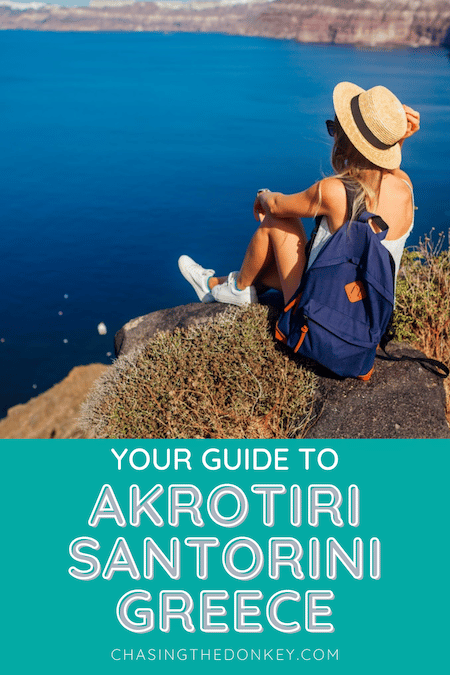
Akrotiri is on the Greek Island of Santorini. The small village is an excellent place for a day out in Santorini to enjoy one of the most scenic beaches on the island and discover the remains of the ancient civilization that once thrived on the island before the huge volcanic explosion that shaped today’s landscape. If you’re visiting Santorini this season and want to discover the area, keep this guide to Akrotiri at hand to know what to do, what to see, and how to spend your time in Akrotiri.
Skip Ahead To My Advice Here!
Where Is Akrotiri
Akrotiri is located on the southwestern coast of Santorini Island, facing the Aegean Sea. It is 15 kilometers south of Fira, the island’s capital, on the slopes of a hill with sea and impressive caldera views.
When To Visit Akrotiri
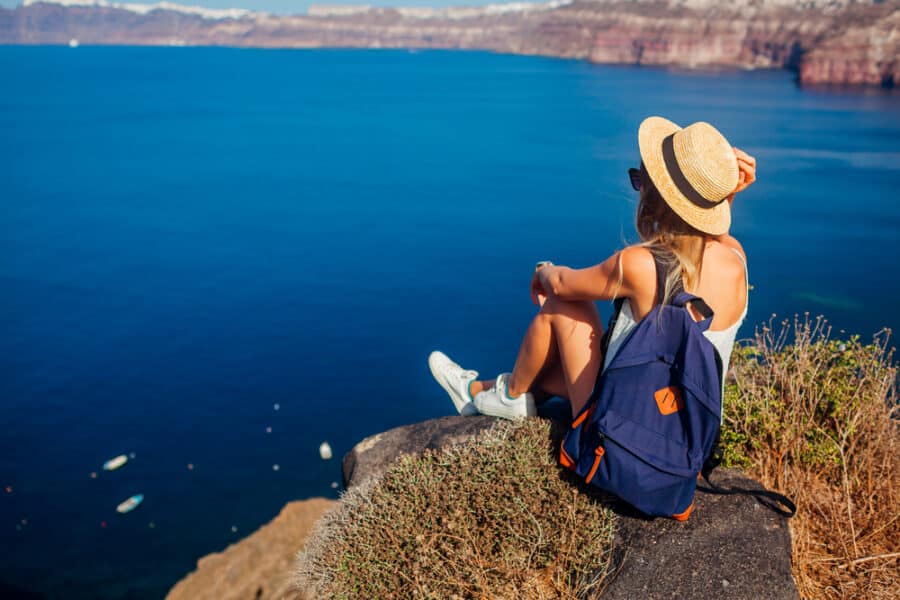
Like the rest of the island, Akrotiri is a year-round destination. However, it is good to consider that thousands of tourists flock to Santorini every summer and that the island is an important destination for those island-hopping in Greece, so if you want to explore the site with fewer crowds (and lower temperatures), then Akrotiri will look at its best during spring and autumn.
If you want to spend time in Akrotiri for its beaches, then summer and spring will be your best time. White Beach can only be reached by boat, so good weather is key to visiting.
If your primary reason to visit Akrotiri is to visit this Santorini archaeological site and the nearby akrotiri museum, then consider that opening days and hours change from season to season; besides, the site offers free admission on some days of the year.
Keep these Akrotiri Archaeological Site details in mind when booking your trip:
- Wednesdays to Mondays, 8:30 am to 3:30 pm
- Closed on Tuesdays (like most archaeological sites and museums in Greece)
- Thursdays to Mondays, 8:30 am to 8:00 pm
- Wednesdays, 8:30 am to 3:30 pm
- Closed on Tuesdays
- 6 March
- 18 April
- 18 May
- Last weekend of September
- 28 October
- The first Sunday of the month during winter (November-March)
Akrotiri Archaeological Site

The Santorini ruins of Akrotiri shelter one of Europe’s oldest and most significant Bronze Age archaeological sites that remained sheltered by a thick layer of volcanic ash for ages, thus preserving the place and many ancient objects in perfect shape. This has allowed archaeologists to unearth some unique findings, learning a lot about the way of life and the economy of this striving prehistoric settlement.
The ancient town of Akrotiri was an important city in the Aegean, with its first inhabitants dating back to the fourth millennium BC, in the Late Neolithic era. Archaeologists have found different elements that make it easy to relate the town of Akrotiri with the Minoan civilization, which thrived on the island of Crete. Therefore, Akrotiri is often also referred to as a Minoan settlement.
Akrotiri enjoyed a central position in the Aegean Sea, leading to increasing geopolitical power. It didn’t take long for the coastal town to become an important port that maintained commercial routes with other islands, including Crete and Cyprus, but also with more distant cultures, such as the Egyptians and the different civilizations that ruled in present Syria (from Sumerians to Assyrians, Hittites, and Babylonians).
As years went by and its economic power increased, the settlement became a central place of commerce in the Aegean Sea, with its important harbor. Commerce included gold, silver, ceramics, locally produced saffron (frescoes depicting saffron harvests have been found in the settlement) but also tin, an important metal that, when alloyed with copper (that probably came from Cyprus), was used to produce bronze… so important that it gave its name to the whole era.
The Minoans of Akrotiri developed to be a remarkable urban center and developed an impressive fleet for trading. Just like Heraklion (Knossos) in Crete, the Minoan society lived in coastal towns, often unprotected and with no protective walls, which proves their focus was on trade and commerce, not on wars. This period is also known as the Minoan Peace due to the lack of warfare. This, however, does not mean that they lacked defensive skills, as their ships were known to have weapons to defend themselves from pirates and sea attacks.
The Destruction Of Akrotiri
You are probably familiar with Pompeii, a whole town that perished under the ashes of Vesuvius in the Italian Peninsula. Akrotiri underwent the same fate back when, around 1600 BC, the entire site was covered by a thick layer of volcanic ash resulting from the largest volcanic eruption in the past 4000 years.
However, and maybe this is the reason why Akrotiri’s history is lesser-known than Pompeii’s, it is believed that the people in Akrotiri may have had the time to predict the eruption and were able to evacuate the settlement. Proof of that is that, contrary to Pompeii, no human remains were found under the ashes and no precious metals or cattle.
This leads us to think that the inhabitants had enough time to gather their most important belongings and flee. It remains a mystery where the inhabitants migrated to.
The Aftermath Of The Volcanic Explosion
The violent and catastrophic eruption is known to have caused massive quakes and tsunami waves, devastating not just the island of Santorini but also other islands and all over the Mediterranean, probably felt as far as Egypt and believed to be one of the largest volcanic eruptions in human history. Different studies argue that the volcano explosion resulted in the ejection of 60 cubic kilometers of rock and ashes, enough to keep the settlement buried for millennia.
An intricate drainage system, paved roads, and alleys, entire buildings (two and three story-homes and workshops) with stone walls, heating, running water, but also balconies, intact doors, and windows. Findings at the site also include home decorations, vases, figurines, and refined frescoes. As a result, Akrotiri is considered among the most important archaeological sites because the whole settlement remained exceptionally preserved, giving light to priceless information about its ancient civilization.
Everyday Life In Akrotiri
Besides the impressive buildings where the inhabitants used to live and work, evidence was found that leads to believe it was an advanced civilization, with a complex economy based on working the land, cultivating grains, vine, saffron, and olives but also dedicated to beekeeping, fishery, and sea trade.
Different ceramic jars, vases, and vessels were also found on the site. Many of these ceramic containers were used to transport goods and preserve and store food, grain, and oil, but also smaller ones were also found, probably used for cooking, eating, and more. They are a great vehicle of information about the Akrotiri society according to their purpose of use.
Many of the multi-story houses portray an upper floor dedicated to everyday life, while the ground floors were devoted to commerce and storage. Plenty of the private rooms were decorated with frescoes, some of which have been restored and are exhibited in many Greek museums.
Other than being exceptional examples of ancient Cycladic art, frescoes are the primary information source better to understand the way of life of Akrotiri’s inhabitants, often depicting their everyday activities and professions.
Prices
- Regular ticket: 12 euro
- Reduced ticket: 6 euro
- Special 3-day ticket: 15 euro (includes access to different sites and museums, including the Akrotiri Archaeological Site, the Archaeological Site of Ancient Thira, and the Archaeological Museum of Prehistoric Thera)
Brands We Use And Trust
The Modern Village Of Akrotiri
Modern Akrotiri is a small town just a short walk from the archaeological site. It is located on a hill with the remains of a Venetian castle sitting atop. Also known as the great Venetian Castle of Akrotiri, the fortress, which is not as well-preserved as you would expect, is still a great place to visit in Akrotiri. It is a tranquil coastal town worth a visit after you’ve checked Akrotiri
ruins.
Also known as La Ponta (Venetian for “peak”), the castle dates back to the thirteenth century, and it was built to offer defense to the fortified settlement during the first years of Venetian occupation on the island. The castle revolved around a defensive tower known as Goulas, and it occupied a strategic position that helped protect the island against pirate raids and the most important menace in the Mediterranean at the time, the Ottoman Empire.
The fortified settlement had a small church and dozens of tiny houses with iron doors. The fortress finally succumbed to Ottoman rule in 1617, and it survived almost intact until 1956, when one of the most severe quakes on Santorini damaged most of the castle’s structure, leaving only ruins behind.
Every year, music festivals and concerts occur in the castle’s areas that weren’t damaged by the earthquake. Moreover, the place now hosts an important music workshop and a musical instrument exhibition. From the top of the Venetian tower, the panoramic views of the island and the coast are amazing. There are guided visits during summer as well, offering the opportunity to learn about the castle’s history and one of the most traditional wind musical instruments in the Greek islands, the tsabouna.
Akrotiri Lighthouse

One of the most visited places in Akrotiri, right after the archaeological site, is the old Lighthouse. The landmark is on the southwestern tip of Santorini and has unique views of the rugged coastline and the sea.
The lighthouse dates to 1892, and it is one of the first lighthouses ever produced in Greece. It was powered by petrol during its first 100 years of activity, with a permanent keeper in charge of the manual operation.
The Akrotiri Lighthouse stands above a small white building that used to be the warden’s house. The total height is ten meters, and it is still active, although it is no longer operated manually and it emits a bright white beam over the sea every 10 seconds.
To visit the site, you can either drive or take the bus from Fira to Akrotiri; once in the village, you can either walk or reach the lighthouse by taxi. The place is popular in summer as it is the scene of one of the most beautiful sunsets on the island. From this area, it is easy to spot the Santorini Volcano, right in the center of the caldera.
Best Beaches Near Akrotiri
Red Beach
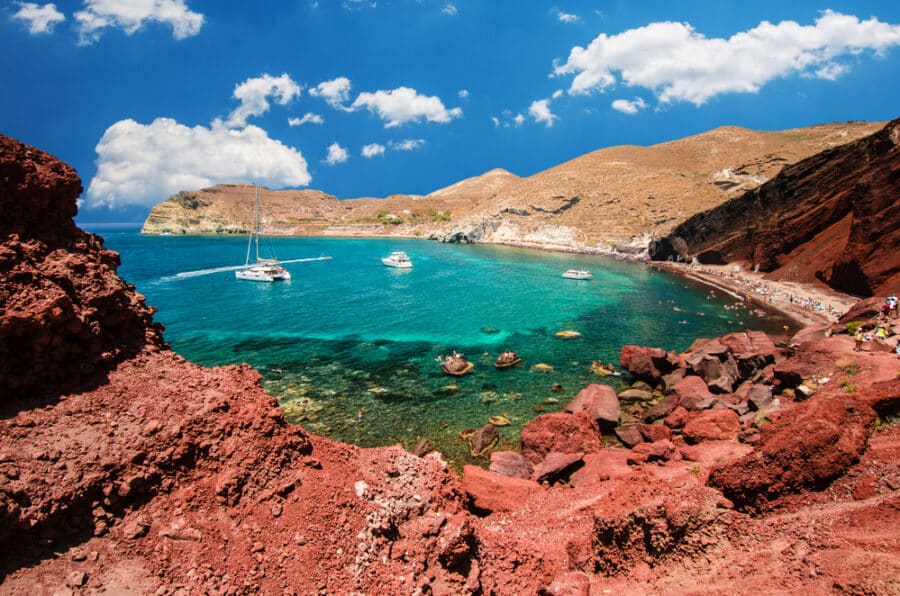
Known in Greek as Kokkini Paralia, this beach is located on the tip of Akrotiri, and it is one of the most beautiful and bizarre shores on the island. To access the beach, it is necessary to hike for a few meters as it is located behind a promontory, not far from the archaeological site.
The different volcanic eruptions formed the Red Beach that the island witnessed during the years. It is surrounded by volcanic rocks of dark colors, black and red pebbles, and dark red sand and is one of the most spectacular places on the island to admire unique rock formations under the sea’s abundant marine life. The whole area offers wild scenery that is not easy to find in any other Greek destination.
If you’re getting to this impressive location from Fira, the drive is about 20 minutes. It is also possible to visit by bus (departing from Fira’s central bus station) or by boat. Many different boat tours take you to explore Red Beach during sunset, a time when the red cliffs behind the beach seem to set on fire with the light of the sun, creating a spectacular landscape.
If you’re planning to spend time on the beach, it is good to know that the organization is limited. You can find some loungers and umbrellas, and two beach bars sell drinks and snacks. Prices tend to be high, so pack all you might need to spend the day in the area.
Don’t forget to carry enough sun protection because there’s no natural shade available, and the beach is directly hit by the sun until the late afternoon. It is also essential to know that the place tends to be extremely hot in summer because the beach is protected from the winds, so there is no ventilation.
White Beach
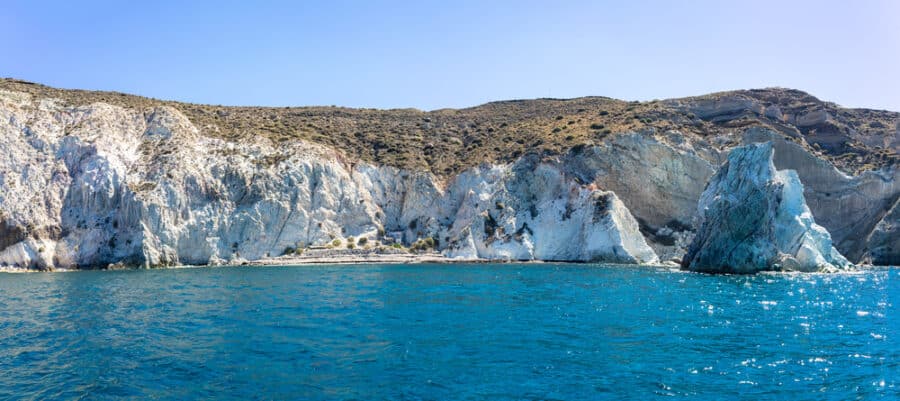
Also, in the Akrotiri area, the White Beach is a gorgeous, secluded beach, locally known as Lefki Ammos (white sand); although the beach features dark volcanic pebbles and grey sand, there is no white sand whatsoever. The beach is surrounded by imposing white cliffs and rocks, which is why the area is known as White Beach.
This unique shore features shallow, emerald waters that contrast with the dark sand and white pebbles, creating a unique environment. There are minimal facilities and organization, so packing all necessary things for spending a day is a must.
There are different ways to visit: a boat is the easiest, most popular, and most accessible. Since it is impossible to drive to White Beach, the only second alternative is to hike from the nearby Kambia Beach.
Boat rides and taxi boats can be hired at the Red Beach or near the southern port of Vlychada, and it is also possible to visit with an organized tour via yacht or catamaran.
Almyra Beach
Located halfway between Red Beach and Vlychada, Almyra Beach is not far from the ancient settlement of Akrotiri. The area is often lonely since the place is relatively isolated and can only be reached on foot following a dirt path.
The beach features smooth and small pebbles and beautiful crystal clear waters. The place is also great for snorkeling, and unique cliffs in the background create a fantastic moon-like atmosphere. The beach is not organized, so get ready to pack drinks and everything you need to spend the day.
Mesa Pigadia Beach
Another beach you can visit in the area of Akrotiri is Mesa Pigadia, very close to the White Beach, the Red Beach, and the lighthouse. It can be accessed by boat or car, although that means driving off-road for a while. The dirt road is in reasonably good condition and safe, with a parking area for visitors.
Where To Stay In Akrotiri, Santorini
Although most hotels are located in the villages of Oia and Imerovigli, as well as in the capital of the island, Fira, there are some stunning hotels you can check out if you want to visit Santorini but want to avoid the hustle of staying in the more popular, whitewashed villages facing the caldera.
Budget
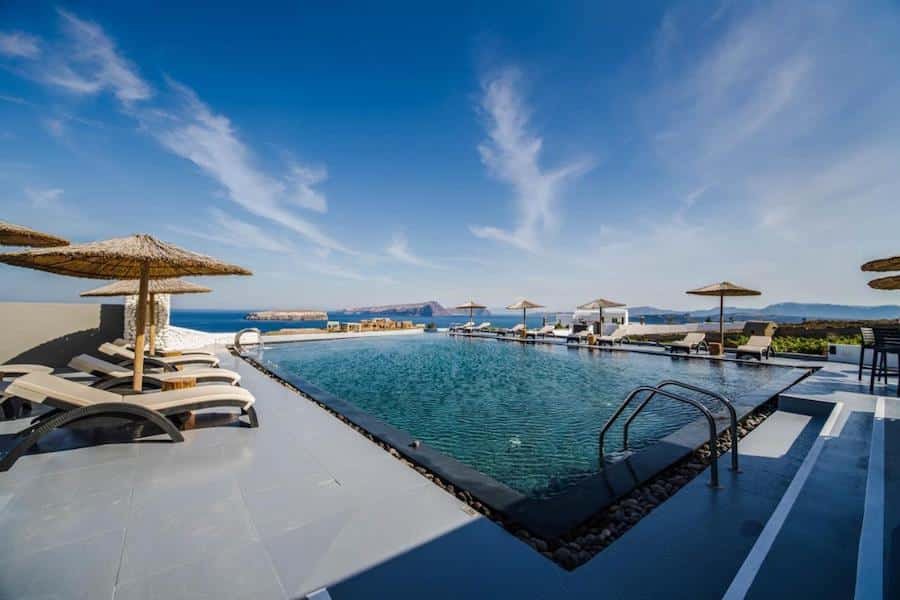
Cape Sisu Suites is an affordable place to stay in the Akrotiri area of Santorini. The hotel features an outdoor pool and scenic views of the sunsets. Guests can enjoy the traditional Cycladic decoration, gorgeous balconies or terraces with sea or garden views, and a bar overlooking the Aegean Sea.
Mid-Range
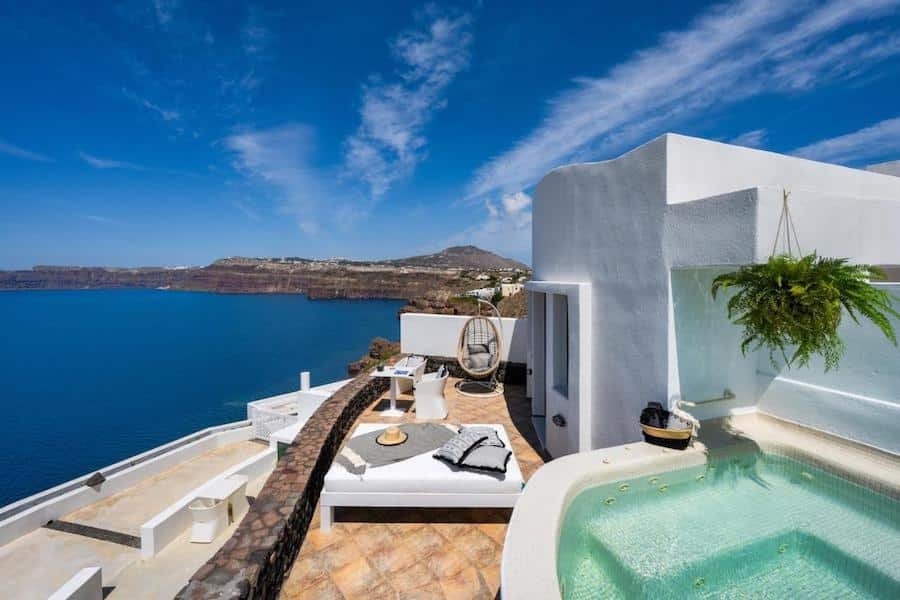
Epic View Suites is a property about 3 minutes from the beach, featuring an outdoor swimming pool, free private parking, a bar, and a garden. The hotel has family rooms, while they also offer both continental and an à la carte morning breakfast.
Luxury
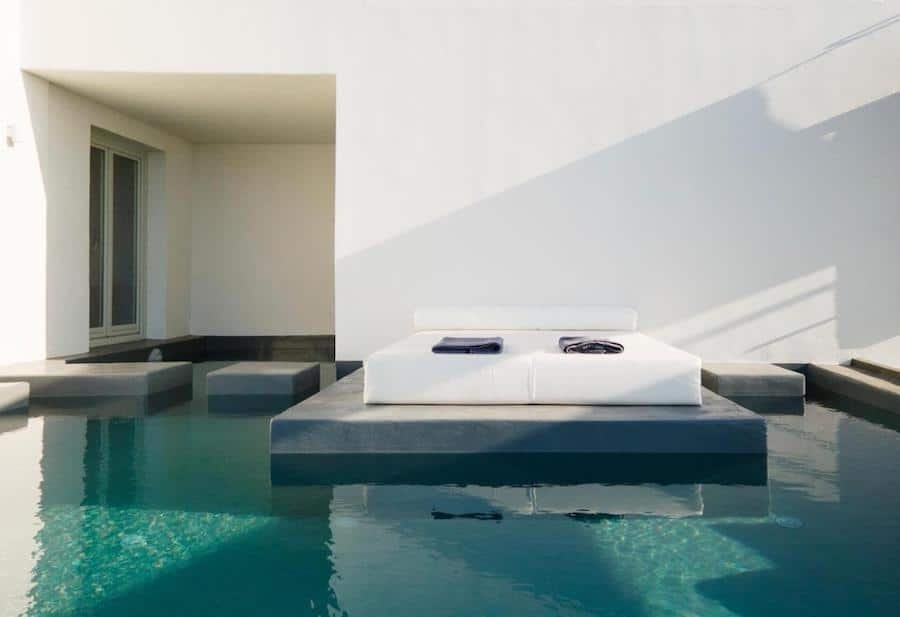
Santonero – The Philoxenia Project is a 5-star hotel with spectacular sea views, a sun terrace, a pool, and guest rooms with modern amenities. The hotel offers continental and à la carte breakfast every day. Some units feature a private patio.
Move This Adventure To Your Inbox & Get An Instant Freebie

No spam. Unsubscribe at any time.
Where To Eat In Akrotiri

Remezzo
Remezzo boasts excellent online reviews. This place offers gorgeous tables with sea views and a traditional Santorinian menu, including fava spread, tomato fritters, fresh fish, and salads—a lovely and romantic spot for dinner at sunset.
Akrothiri (Bistro Cafe & Cocktail Bar)
Akrothiri (Bistro Cafe & Cocktail Bar) is located in the traditional village of Akrotiri, and it is a good place for every meal, starting with a delicious morning breakfast.
The Good Heart
The Good Heart is one of the most traditional places in Akrotiri for unforgettable Greek food. All the food served in the restaurant is organically grown by the family who runs the place in the surrounding area.
So, do you now feel ready and empowered to visit Akrotiri and check out the Pompeii of Greece?

